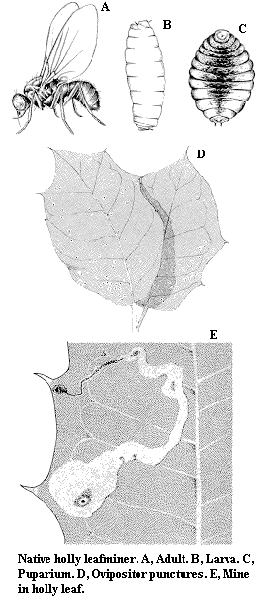Key to Holly Pests
Hollies, with their tremendous variation in growth habits, leaf size, shape, and color, and sometimes showy berries, are highly desirable landscape plants. Over 11 million hollies of 42 varieties are produced in Southern nurseries each year. Although numerous insects and mites have been collected from hollies, plants often withstand prolonged infestations without visible deleterious effects. Other than in a commercial nursery, the presence of a few insects or mites on a holly is no reason for great alarm. The native holly leafminer, Japanese wax scale, and southern red mites are the most frequently reported pests of hollies in the southeastern United States.
- Japanese wax scale – White, waxy blobs up to 6 mm in diameter appear on limbs and twigs. They are often accompanied by sooty mold.
- Native holly leafminer – Irregular, elongate, yellow or brown splotches on upper leaf surface (tunnels); small, chunky maggots in tunnel. (Adults rarely found.).
- Southern red mite – Small chlorotic spots on leaf surface, heavily infested leaves becoming bronze in color; tiny, spiderlike animals (spider mites) on lower leaf surface usually in spring or fall.
- Tea Scale – Cottony masses are evident on the lower leaf surface. Sooty mold may be present, and plant vigor may be impaired.
Native Holly Leafminer
Native holly leafminer, Phytomyza ilicicola Loew, Agromyzidae, DIPTERA
DESCRIPTION
Adult – The adult is a small (2.5-mm), black and gray fly. The first two segments of the antennae are gray, and the third segment is black. The native holly leafminer female is generally more active than the male. There is only one generation per year.
Egg – The white egg is oval and 0.25 mm long.
Larva – The pale-yellow, legless larva is tapered from front to back, with its head retracted into the body. The larva is 1.5 mm long.
Pupa – The oval pupa is reddish brown, 2 mm long, and uniformly tapered to blunt points at both ends.
BIOLOGY
Distribution – As the name implies, the native holly leafminer is indigenous to the United States. It is found along the East Coast and westward into Ohio and Alabama.
Host Plants – The native holly leafminer has infested American, Japanese, Chinese, English, and yaupon hollies. Other hosts include winterberry (or black alder) and inkberry (or bitter gallberry) and their varieties. The fly is particularly damaging to the American hollies.
Damage – It is the most injurious insect pest of holly in the eastern United States. The larval leaf-mining can cause partial defoliation, especially during a dry season; and the mines make the trees unattractive. Moreover, the females insert their ovipositors into the leaf tissue, causing wounds from which sap flows. Both females and males then feed on the sap. This wounding deforms the leaves. The leafminers prefer new growth.
Life History – There are three larval stages in the life cycle of this fly, the last of which overwinters. In March and April the larvae pupate, and adult flies begin to emerge in May. They have a brief lifespan; females live 3 days, males only 2. Eggs are inserted into the undersides of newly formed leaves, causing tiny, green blisters to appear on the leaf bottoms. Most eggs are laid near the tips of the leaves, close to the midveins. Eggs hatch in about 4 days. The larvae mine into the leaves, remaining there for 9 to 10 months. The mines are yellowish brown and usually contain only one larva apiece. Each serpentine mine eventually broadens into a blotch, which contains the pupa. Just before each larva pupates, it prepares a circular exit hole covered by a thin layer of leaf cells.
CONTROL
If only a few plants are damaged, picking the mined leaves and burning them gives some control. For specific chemical controls, see the current state extension recommendations.
Publication date: Jan. 1, 1993
AG-189
Other Publications in Insect and Related Pests of Shrubs
N.C. Cooperative Extension prohibits discrimination and harassment regardless of age, color, disability, family and marital status, gender identity, national origin, political beliefs, race, religion, sex (including pregnancy), sexual orientation and veteran status.

